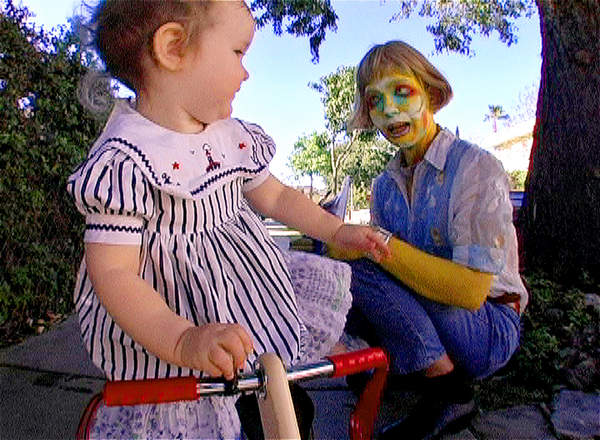Moving Image: on Ryan Trecartin
by Travis Jeppesen on October 7, 2015
My essay, “Exploding the Frame: Ryan Trecartin’s Bad Language,” appears in the new anthology Moving Image edited by Omar Kholeif, part of the “Documents of Contemporary Art” series from Whitechapel Gallery.
The essay can also be read below.
The RealityTV script is, by now, formulaic, easy enough to decode by nearly anyone. It’s been around for a generation, the youngest among us has known no other function of television other than constructing and presenting a mediated form of reality. Ryan Trecartin’s work, and in particular his film I-Be Area, is both an amplification and distortion of that script. RealityTV changes our whole perception of reality; reality is now something you watch on a screen. In I-Be Area, we get screen upon screen upon screen upon endless screen. The screen is both filter and transmitter of heavily performed and heavily edited reality. Although there are many different settings, the entire action of the film occurs within a single zone, which is both RealityTV amplified and Reality© amplified, a space where all interactions are heavily scripted in order to orchestrate the illusion of chaos and a natural collusion of conflicting wills, a locale controlled by a god whose iterability manifests itself in a total situationality that is occluded by the all-recording digitalized presence. Affectation and gesture become just as important as the text being deployed by the participants in these multiproliferatory screens; they become the emotive norms that encase the seemingly random collage of words and ideas that form the script—thoughts melting into one another linguistically because one thought can never be completed: a New Real Order.
There are many different ways of watching I-Be Area. It’s like taking a different ride each time: There is the participatory way, wherein you join the party, projecting your own zone of being and becoming into the “total minimal situation” that the film proclaims; the narrative engulfment, in which you attempt to navigate the “multilinear” (Kevin McGarry) pathways that the plot entails; the linguistico-linear tributary, immersing yourself in the piece’s pure language stream, finding the sense in the seeming nonsense; imagistic engulfment, giving yourself over to the sensory overload in the piece’s manic cuts, the repeated strains of neon color, the detailed visual anarchy of the sets and costumes; the energo-intensive path, wherein affectation becomes your beaming guide; the elemental way, in which you attempt to sort out the millions of parts that form the spectral collage of the whole.
In all likelihood, however, your way of taking in I-Be Area will combine all or many of these methods, thus putting you in a schizo delirium that may repel or enliven you, depending on your openness towards destabilization and the manic mediation that forms the fabric of RTV and R©. All of your impulses become amplified, the aim of your desires is no longer certain, stable identity becomes a joke.
It can be a discomfiting ride to take, which makes it all the more worthwhile.
It should be noted, however, that there can be no characterological way of watching I-Be Area, because in a topia where identity is so fluid, there can be nothing so solid as character—thus there is no such thing as a standard linear narrative. Rather, the triumph of simultaneity—both the multiplicity inherent in being and in situationality. (In one of Trecartin’s subsequent films from the Any Ever series, a character suggests re-writing the US Constitution and replacing the word “God” with “Internet” and “people” with “situations.”)
If the film can be said to be “about” anything (this “about” is always the worst thing anyone could ask of an artist—though we often do), then it is the dissolution of identity into a sort of digital being—a hallmark of the New Real Order. Don’t like your identity? Buy a new one online, pay with plastic. Don’t react; redact! “Sometimes I feel like a prequel to a horrible person,” says one persona early on in the film. This embrace of becoming—a multiplicity of selves (every one is different people, different genders)—is certainly a generational influence; an abundance of youth marks every Trecartin statement. Despite the current shadows looming over the civilized West, we must keep in mind that the RTV generation was reared into an attitude reflecting an overload of confidence, unafraid of the consequences of taking risks — unafraid of appearing stupid. It is this latter fact that allows for so much of the vileness of RealityTV, and which I-Be Area subtly mocks. “What will I be when I grow up?” asks I-Be after he has been transformed into a new avatarial persona, Oliver. “A production company!” he/she answers. Media and the means of mediation are newly morphed into one with technology’s showboating and accessibility; not only is everything shot in HD, the cameras are often visible and frequently held by the speaking persona. Nearly every line of dialogue in the film is spoken directly to the camera, reflecting a consciousness of the process of mediation, a demolition of the fourth wall borrowed from the theater, which RTV typically attempts to avoid, in its artificial framing of “authenticity.”
Departing from the recurring concept of adoption—of babies, but also, by extension, implying the incorporative becoming of new selves—individuals drift into new personae readily and without hesitation. Everything is temporary, and so the heavy burden of ontological meaning is absent. An avatar can become “a toxic bisexual wearing unstable flip flops” before finding her/himself a living, walking meme. In this zone, everything is temporary. Dialects and personalities can be picked up and discarded alongside wigs and make-up. Tangible is intangible and vice versa. Interactions are pure—no psychology, just a super-psychology, overburdened with mediated emotions. “Major” and “minor”—events, personae, substance, objects—become equal and are thus no longer worthwhile distinguishing.
The loss of agency this process entails is not necessarily a bad thing. In the film’s “Moms” scene, in which a group of mothers gathers together in a middle-class suburban living room in order to vote one of the mothers off the show that the film has suddenly become, the excluded mother proclaims, “I can’t believe New Jersey happened to me. It was like writing a book I had no control over.” Instead, in such an equalized universe, a realm where agency is absent or altered, in which subjectivity is therefore spectral and momentary, it all comes down to mattering. “That will be a good day,” shouts the excluded mom: “When it won’t matter!”
Projectile bodies mattering all over the supra-mediated normvoid.
“Do you know what your dad is?”
“My dad is a building that we lit on fire.”
Just as you begin to think it’s all like a high school drama improv class gone totally haywire, the setting shifts and enters into…well, what appears to be a high school drama improv class. While narrative shifts occur all the time throughout I-Be Area, in keeping with the multi-linearity that is the underlying aura of the piece, a major shift nonetheless can be detected about an hour into the film. Or, perhaps: a shift of realms. This new realm is a classroom compound overruled by a pregnant authoritarian teacher, Jamie, and her muse, Ramada Omar. Jamie sits with her legs spread wide open and squats constantly while standing, always about to give birth. Ramada Omar rolls around on the floor, squealing “This is my favorite interactive!”
“It’s not phone you person go call yourself!” responds Jamie.
How does all this mattering come to resolve itself in the light of the total minimal situation? Perception, after all, can also be a physical object in these heightened terms. Saying is an object; so is this gesture. “No symbols where none intended,” Beckett famously wrote at the end of his novel Watt, but how to read in the absence of symbols? Do reading and being become intertwined through projection and participation? How does the frame manage to function when its contents’ aim is to completely decimate the material structure of its container?
We have to see the RTV zone for the metaphysical failure that it is. Just as, say, human laws cannot physically prevent someone from committing a crime, our own physical containers can no longer contain us, if they ever did. I-Be Area is the drama of this failed containment, a literal and ritual purging of the frame. Don’t tell me what something is; rather, inhabit it.
In the end, the personae trapped in the zone that I-Be Area inhabits are desperate to get out of it, to bust it up. They are constantly picking up hammers, breaking glass, destroying the set, fueling the increasingly frenzied chaos that is the artificial guise of their inhabited voidosphere.
Where to go once one finally manages to escape? Escaping is never about re-location—it is about the very act of escaping. The answer is never “there,” more like “there-ing.” Perhaps it’s too unsettling, this sudden cognizance that there is no final destination, only constant movement in store. If there is any true reality, then it is in the machinic nature of shifty becomings, the drive to escape the inescapable. Perhaps the right attitude is best expressed by one of Trecartin’s all-too-“real” personae: “Fuck you and sign out.”



Leave your comment